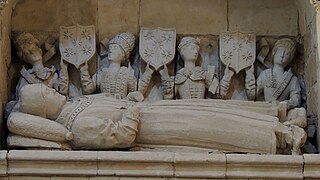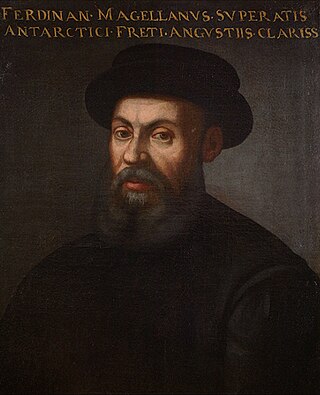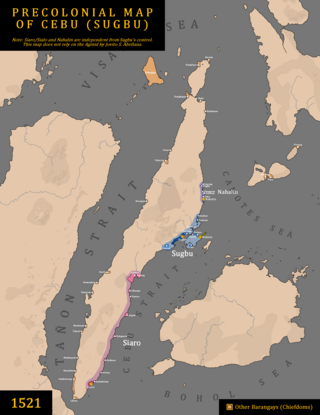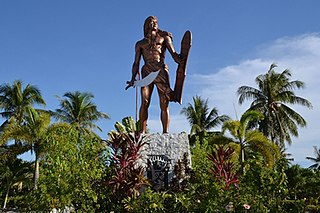Related Research Articles

The Battle of Mactan was fought on a beach in Mactan Island between Spanish forces led by the Portuguese explorer Ferdinand Magellan along with local allies, and Lapulapu, the chieftain of the island, on the early morning hours of April 27, 1521. Magellan, a Portuguese-born commander serving the Spanish Empire who led an expedition that ultimately circumnavigated the world for the first time, commanded a small Spanish contingent in an effort to subdue Mactan led by Lapulapu under the Spanish crown. The sheer number of Lapulapu's forces, compounded with issues on the location and armor, ultimately resulted in a disastrous defeat to the Europeans and the death of Magellan. Surviving members of Magellan's crew continued the expedition under the command of Juan Sebastian de Elcano, who completed the journey in September 1522.

The Magellan Telescopes are a pair of 6.5-metre-diameter (21 ft) optical telescopes located at Las Campanas Observatory in Chile. The two telescopes are named after the astronomer Walter Baade and the philanthropist Landon T. Clay. First light for the telescopes was on September 15, 2000 for the Baade, and September 7, 2002 for the Clay. A consortium consisting of the Carnegie Institution for Science, University of Arizona, Harvard University, the University of Michigan and the Massachusetts Institute of Technology built and operate the twin telescopes. The telescopes were named after the sixteenth-century Portuguese explorer Ferdinand Magellan.

Duarte Barbosa was a Portuguese writer and officer from Portuguese India. He was a scrivener in a feitoria in Kochi, and an interpreter of the local language, Malayalam. Barbosa wrote the Book of Duarte Barbosa c. 1516, making it one of the earliest examples of Portuguese travel literature.

Magellan's Cross Pavilion is a stone kiosk in Cebu City, Philippines. The structure is situated on Plaza Sugbo beside the Basilica del Santo Niño It houses a Christian cross that was planted by explorers of the Spanish expedition of the first circumnavigation of the world, led by Ferdinand Magellan, upon arriving in Cebu in the Philippines on April 21, 1521.

Victoria or Nao Victoria was a carrack famed as the first ship to successfully circumnavigate the world. Victoria was part of the Spanish expedition to the Moluccas commanded by the explorer Ferdinand Magellan.

Juan Rodríguez de Fonseca (1451–1524) was a Spanish archbishop, a courtier and bureaucrat, whose position as royal chaplain to Queen Isabella enabled him to become a powerful counsellor to Ferdinand and Isabella, the Catholic Monarchs. He controlled the Casa de Contratación, an agency which managed expeditions to the New World on behalf of the Spanish crown. He later served as the president of the Council of the Indies, when it was founded in 1521. He managed the administration of a number of significant Spanish expeditions including voyages by Christopher Columbus and Magellan's circumnavigation of the earth.

The Ferdinand Magellan is a former Pullman Company private car that served as Presidential Rail Car, U.S. Number 1 from 1943 until 1958. It is named after the Portuguese explorer. The current owner, Gold Coast Railroad Museum in Miami-Dade County, Florida, acquired it in 1959. The Ferdinand Magellan was designated a National Historic Landmark by the United States Department of the Interior, National Park Service on February 4, 1985.

Francisco Serrão was a Portuguese explorer and a possible cousin of Ferdinand Magellan. His 1512 voyage was the first known European sailing east past Malacca through modern Indonesia and the East Indies. He became a confidant of Sultan Bayan Sirrullah, the ruler of Ternate, becoming his personal advisor. He remained in Ternate where he died around the same time Magellan died.

Diogo Ribeiro was a Portuguese cartographer and explorer who worked most of his life in Spain, where he was known as Diego Ribero. He worked on the official maps of the Padrón Real from 1518 to 1532. He also made navigation instruments, including astrolabes and quadrants.

The Magellan expedition, sometimes termed the Magellan–Elcano expedition, was a 16th-century Spanish expedition planned and led by Portuguese explorer Ferdinand Magellan. One of the most important voyages in the Age of Discovery—and in the history of exploration—its purpose was to cross the Atlantic and Pacific Oceans to open a trade route with the Moluccas, or Spice Islands, in present-day Indonesia. The expedition departed Spain in 1519 and returned there in 1522 led by Spanish navigator Juan Sebastián Elcano, who crossed the Indian Ocean after Magellan's death in the Philippines. Totaling 60,440 km, or 37,560 mi, the nearly three-year voyage achieved the first circumnavigation of Earth in history. It also revealed the vast scale of the Pacific Ocean and proved that ships could sail around the world on a western sea route.
Rajah Humabon later baptized as Don Carlos Valderrama, was one of the recorded chiefs in Cebu who encountered Ferdinand Magellan in the 16th century. Humabon ruled at the time of the arrival of Portuguese-born Spanish explorer Ferdinand Magellan in the Philippines in 1521. Humabon, his wife, and his subjects were the first known Christian converts in the Philippines. However, since there were no Catholic priests in Cebu from 1521 to 1565, this Christianity was not practised until the return of the Spaniards to Cebu. There is no official record of Humabon's existence before the Spanish contact. The existing information was written by Magellan's Italian voyage chronicler, Antonio Pigafetta on Humabon and the indigenous Philippine peoples that existed prior to Spanish colonization. Rajah Humabon is cited as the reason for why Magellan fought in the Battle of Mactan, as the latter wanted to earn the trust of Humabon by helping him subdue his opponent Lapulapu, one of the chiefs of Mactan. Despite being referred to as "king" in the journal of Antonio Pigafetta, he was not one like in the manner of a monarch in centralized societies, it is plausible that the title was mistakenly applied because according to succeeding chroniclers, there were no kingdoms in the pre-colonial Philippines.

Ferdinand Magellan was a Portuguese explorer best known for having planned and led the 1519–22 Spanish expedition to the East Indies, which achieved the first circumnavigation of Earth in history. During the expedition, he also discovered the Strait of Magellan, allowing his fleet to pass from the Atlantic into the Pacific Ocean and perform the first European navigation to Asia via the Pacific. Magellan died in the Philippines during his voyage, and his crew completed the return trip to Spain in 1522.

The recorded history of the Philippines between 900 and 1565 begins with the creation of the Laguna Copperplate Inscription in 900 and ends with the beginning of Spanish colonization in 1565. The inscription records its date of creation in 822 Saka. The discovery of this document marks the end of the prehistory of the Philippines at 900 AD. During this historical time period, the Philippine archipelago was home to numerous kingdoms and sultanates and was a part of the Indosphere and Sinosphere.

The Rajahnate of Cebu or Cebu also called as Sugbu, was an Indianized Raja monarchy Mandala (Polity) on the island of Cebu in the Philippines prior to the arrival of the Spanish conquistadors. It is known in ancient Chinese records as the nation of Sokbu (束務). According to Visayan oral legend, it was founded by Sri Lumay or Rajamuda Lumaya, a minor prince of the Tamil Chola dynasty. He was sent by the Chola emperor from southern India to establish a base for expeditionary forces, but he rebelled and established his own independent polity. The capital of the nation was Singhapala (சிங்கப்பூர்) which is Tamil-Sanskrit for "Lion City", the same rootwords with the modern city-state of Singapore.
The year 1521 in science and technology included many events, some of which are listed here.

The flag of Magallanes y la Antártica Chilena Region is one of the regional symbols of the Chilean Magallanes y la Antártica Chilena Region. The flag was adopted in 1997 by the regional government, along with the Regional Coat of Arms.

The Magellan expedition was the first voyage around the world in human history. It was a Spanish expedition that sailed from Seville in 1519 under the initial command of Ferdinand Magellan, a Portuguese sailor, and completed in 1522 by Spanish Basque navigator Juan Sebastián Elcano.
1521 in the Philippines details events of note that happened in the Philippines in the year 1521.

The Concepción was an early 16th-century Spanish carrack during the Age of Discovery, chiefly remembered as part of the five-ship Molucca Fleet that undertook the historic 1519–22 Magellan expedition.

Mactan Shrine, also known as Liberty Shrine, is a memorial park on the island of Mactan in Lapu-Lapu City, Philippines. It hosts two monuments, namely the Magellan Monument, which is dedicated to Portuguese explorer Ferdinand Magellan and the Lapu Lapu Monument, a bronze statue which commemorates Lapu Lapu, a native leader who defeated Spanish soldiers led by Magellan in the 1521 Battle of Mactan.
References
- ↑ "Ferdinand Magellan", Catholic Encyclopedia, New Advent, retrieved 2007-01-14